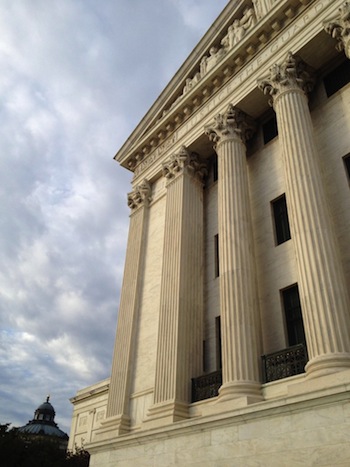Yesterday and today, the United States Supreme Court is hearing oral arguments on a pair of cases challenging state and federal laws that define marriage. The first case, Hollingsworth v. Perry, takes on the issue of whether Proposition 8, California’s state ban on same-sex marriage, is unconstitutional. The second case, United States v. Windsor, asks whether a portion of the Defense of Marriage Act (DOMA) is unconstitutional and whether the federal government must recognize legally married same-sex couples.
Even though these arguments are being heard this week, the cases have been on our radar screen for years, and in the most unexpected ways. For some, we remember hearing San Francisco Mayor Gavin Newsome proclaiming that same-sex marriage will happen “whether you like it or not.” Others recall the highly-anticipated production of “8,” a play reenacting closing arguments of the Prop 8 challenge in federal court and starring Hollywood’s elite, including Brad Pitt and George Clooney. Most recently, we have been able to drink our venti, non-fat, extra-hot café mistos with a clear conscience after learning that Starbucks CEO Howard Schultz shot down an investor at a shareholder’s meeting when the investor claimed corporate support of same-sex marriage was bad for business.
These moments stand out, perhaps as much as the legal battles do, and have become embedded within American popular culture. They leave me thinking about the relationship between law and culture. Many are familiar with the age-old question of which came first the chicken or the egg, and there’s a similar question in law: which came first, the case or the culture? This question may not be existential, but it raises an important causal question concerning law and social change and has become quite relevant in the recent same-sex marriage challenges.
The Case for Culture
The most common response to my question is that American culture and popular opinion precede major legal victories. Currently, public opinion trends show a tidal tsunami-like shift on the issue. For the first time, a majority of Americans support same-sex marriage. A Washington Post-ABC News poll shows that support for same-sex marriage is at an all-time high at 58 percent, 81 percent among younger generations. Neither in the civil rights movement nor the women’s movement did we see such a clear and rapid shift in opinion on a major issue.
So why does culture matter? For starters, Justice Anthony Kennedy, the predictably unpredictable swing-vote, has given considerable weight to public opinion and cultural norms about social issues when deciding cases, including abortion, juvenile death penalty, and sodomy laws. Therefore, it was no surprise during the Prop 8 oral argument that Kennedy took issue with the comparison of same-sex marriage to the Court’s 1967 ruling in Loving v. Virginia, which struck down laws banning interracial marriage. Justice Kennedy noted that anti-miscegenation laws had been illegal in other countries for hundreds of years, whereas same-sex marriage was “new to the United States,” and said therefore to begin thinking about these issues puts the Court into “unchartered waters.” Similarly, Justice Alito probed Prop 8 challengers with his statement “you want us to step in and render a decision based on an assessment of the effects of [same-sex marriage], which is newer than cell phones or the Internet? … On a question like that, of such fundamental importance, why should it not be left for the people, either acting through initiatives and referendums or through their elected public officials?”
Many scholars also show that courts tend to track public opinion. For decisions that lead to large-scale, social transformation–e.g., desegregation of schools–courts tend to act only if the general public is in favor. Put another way, courts largely represent and codify social change and are not the vanguard of it.
However, when courts get ahead of public opinion, backlash follows. The Supreme Court’s affirmation of abortion rights in Roe v. Wade sparked an intense right-to-life movement that created a cultural and political division that continues today. In the context of same-sex marriage, early victories in Hawaii (1993) and Massachusetts (2003) resulted in considerable backlash, including the passage of the Defense of Marriage Act (DOMA) and constitutional bans of same-sex marriage.
The Case for the Case
While there is convincing academic research that shows court decisions reflect public opinion, there are those that appear to run against it (e.g., flag burning). Ultimately, highly-visible court cases are necessary to cast a spotlight on the issues. I argue that cases can and sometimes should precede culture because court decisions, regardless of the outcome, are much-needed catalysts for broad cultural discussions. Some decisions, I argue, have little to do with the law itself, but instead provide potential for groups to mobilize and express their grievances using the language of the law. Social science scholarship shows that “framing” beliefs and objectives through law is particularly powerful when it comes to articulating the grievances and objectives of a group, and it can influence rhetoric that touches on deeply held cultural values and ideals like fairness, equality, or freedom.
Prop 8 is not simply an unwieldy procedural question about “standing,” and whether the Supreme Court should decide on the case. The litigation challenging same-sex marriage has challenged people to think about equal rights and whether the institution of marriage is about love, procreation or something all together different. Ted Olson, one of the attorneys arguing against Prop 8, captured this idea after oral argument: “I think one of the most important things that happened today was the fact that the American people were listening to the argument.” And the public has made clear that this case is more than just a question of procedure: dozens of rallies have taken place leading up to it, Facebook users changed their profile pictures to a red and pink “Equal Rights,” and many anxiously await the release of the Supreme Court transcripts shortly after attorneys waged war with the Justices over “procedural” matter.









